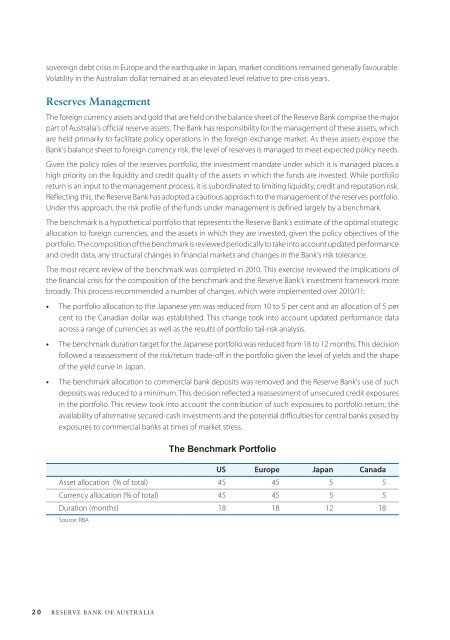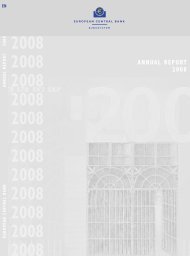Reserve Bank of Australia Annual Report 2011
Reserve Bank of Australia Annual Report 2011
Reserve Bank of Australia Annual Report 2011
You also want an ePaper? Increase the reach of your titles
YUMPU automatically turns print PDFs into web optimized ePapers that Google loves.
sovereign debt crisis in Europe and the earthquake in Japan, market conditions remained generally favourable.<br />
Volatility in the <strong>Australia</strong>n dollar remained at an elevated level relative to pre-crisis years.<br />
<strong>Reserve</strong>s Management<br />
The foreign currency assets and gold that are held on the balance sheet <strong>of</strong> the <strong>Reserve</strong> <strong>Bank</strong> comprise the major<br />
part <strong>of</strong> <strong>Australia</strong>’s <strong>of</strong>ficial reserve assets. The <strong>Bank</strong> has responsibility for the management <strong>of</strong> these assets, which<br />
are held primarily to facilitate policy operations in the foreign exchange market. As these assets expose the<br />
<strong>Bank</strong>’s balance sheet to foreign currency risk, the level <strong>of</strong> reserves is managed to meet expected policy needs.<br />
Given the policy roles <strong>of</strong> the reserves portfolio, the investment mandate under which it is managed places a<br />
high priority on the liquidity and credit quality <strong>of</strong> the assets in which the funds are invested. While portfolio<br />
return is an input to the management process, it is subordinated to limiting liquidity, credit and reputation risk.<br />
Reflecting this, the <strong>Reserve</strong> <strong>Bank</strong> has adopted a cautious approach to the management <strong>of</strong> the reserves portfolio.<br />
Under this approach, the risk pr<strong>of</strong>ile <strong>of</strong> the funds under management is defined largely by a benchmark.<br />
The benchmark is a hypothetical portfolio that represents the <strong>Reserve</strong> <strong>Bank</strong>’s estimate <strong>of</strong> the optimal strategic<br />
allocation to foreign currencies, and the assets in which they are invested, given the policy objectives <strong>of</strong> the<br />
portfolio. The composition <strong>of</strong> the benchmark is reviewed periodically to take into account updated performance<br />
and credit data, any structural changes in financial markets and changes in the <strong>Bank</strong>’s risk tolerance.<br />
The most recent review <strong>of</strong> the benchmark was completed in 2010. This exercise reviewed the implications <strong>of</strong><br />
the financial crisis for the composition <strong>of</strong> the benchmark and the <strong>Reserve</strong> <strong>Bank</strong>’s investment framework more<br />
broadly. This process recommended a number <strong>of</strong> changes, which were implemented over 2010/11:<br />
••<br />
The portfolio allocation to the Japanese yen was reduced from 10 to 5 per cent and an allocation <strong>of</strong> 5 per<br />
cent to the Canadian dollar was established. This change took into account updated performance data<br />
across a range <strong>of</strong> currencies as well as the results <strong>of</strong> portfolio tail-risk analysis.<br />
••<br />
The benchmark duration target for the Japanese portfolio was reduced from 18 to 12 months. This decision<br />
followed a reassessment <strong>of</strong> the risk/return trade-<strong>of</strong>f in the portfolio given the level <strong>of</strong> yields and the shape<br />
<strong>of</strong> the yield curve in Japan.<br />
••<br />
The benchmark allocation to commercial bank deposits was removed and the <strong>Reserve</strong> <strong>Bank</strong>'s use <strong>of</strong> such<br />
deposits was reduced to a minimum. This decision reflected a reassessment <strong>of</strong> unsecured credit exposures<br />
in the portfolio. This review took into account the contribution <strong>of</strong> such exposures to portfolio return, the<br />
availability <strong>of</strong> alternative secured-cash investments and the potential difficulties for central banks posed by<br />
exposures to commercial banks at times <strong>of</strong> market stress.<br />
The Benchmark Portfolio<br />
US Europe Japan Canada<br />
Asset allocation (% <strong>of</strong> total) 45 45 5 5<br />
Currency allocation (% <strong>of</strong> total) 45 45 5 5<br />
Duration (months) 18 18 12 18<br />
Source: RBA<br />
20 <strong>Reserve</strong> bank <strong>of</strong> <strong>Australia</strong>





![KNOW YOUR NEW GIBRALTAR BANKNOTES - [Home] bThe/b](https://img.yumpu.com/50890985/1/184x260/know-your-new-gibraltar-banknotes-home-bthe-b.jpg?quality=85)
![PAPUA NEW GUINEA - [Home] - Polymer Bank Notes of the World](https://img.yumpu.com/49758743/1/190x143/papua-new-guinea-home-polymer-bank-notes-of-the-world.jpg?quality=85)










